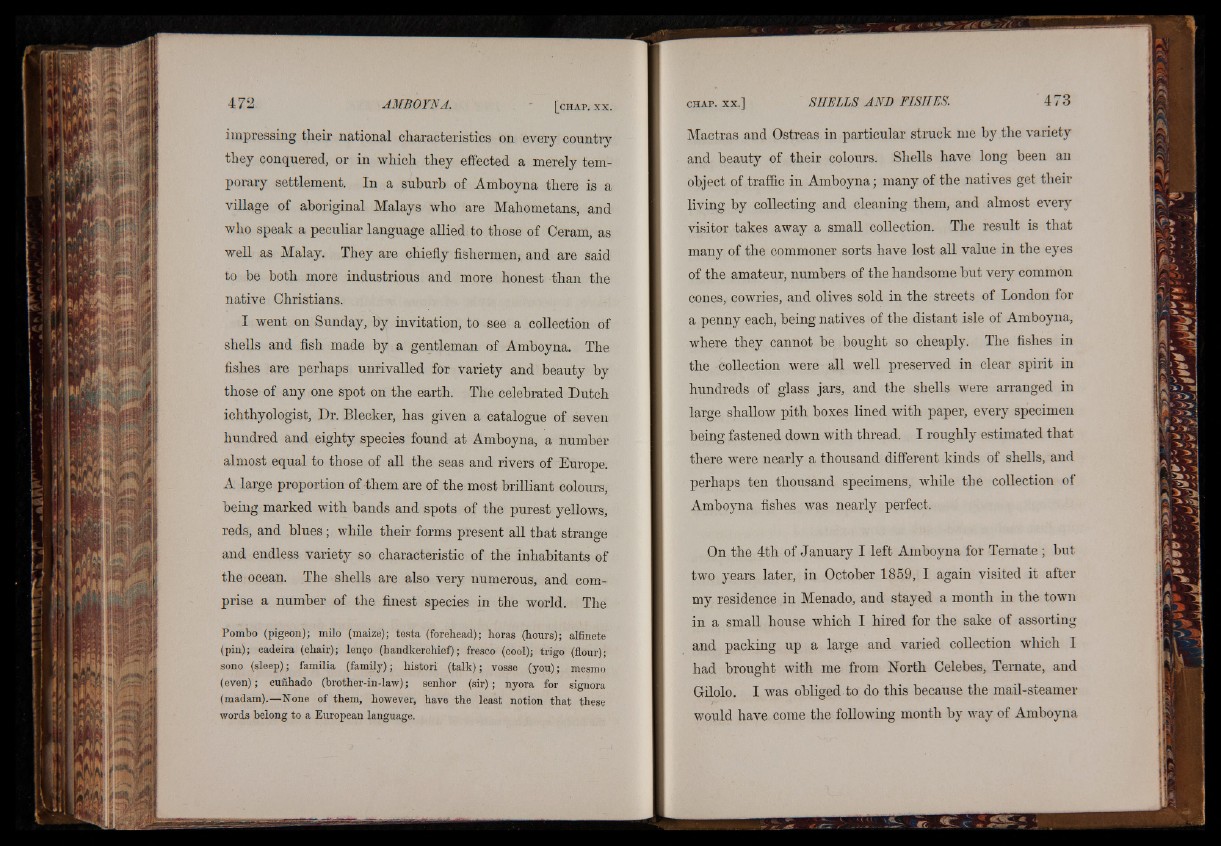
impressing their national characteristics on every country
they conquered, or in which they effected a merely temporary
settlement. In a suburb of Amboyna there is a
village of aboriginal Malays who are Mahometans, and
who speak a peculiar language allied to those of Ceram, as
well as Malay. They are chiefly fishermen, and are said
to be both more industrious and more honest than the
native Christians.
I went on Sunday, by invitation, to see a collection of
shells and fish made by a gentleman of Amboyna. The
fishes are perhaps unrivalled for variety and beauty by
those of any one spot on the earth. The celebrated Dutch
ichthyologist, Dr. Blecker, has given a catalogue of seven
hundred and eighty species found at Amboyna, a number
almost equal to those of all the seas and rivers of Europe.
A large proportion of them are of the most brilliant colours,
being marked with bands and spots of the purest yellows,
reds, and blues; while their forms present all that strange
and endless variety so characteristic of the inhabitants of
the ocean. The shells are also very numerous, and comprise
a number of the finest species in the world. The
Pombo (pigeon); milo (maize); testa (forehead); horas (hours); alfinete
(pin); cadeira (chair); lengo (handkerchief); fresco (cool); trigo (flour);
sono (sleep); familia (family); histori (talk); vosse (you); mesmo
(even); eunhado (brother-in-law); senhor (sir); nyora for signora
(madam).—None of them, however, have the least notion tha t these
words belong to a European language.
Madras and Ostreas in particular struck me by the variety
and beauty of their colours. Shells have long been an
object of traffic in Amboyna; many of the natives get their
living by collecting and cleaning them, and almost every
visitor takes away a small collection. The result is that
many of the commoner sorts have lost all value in the eyes
of the amateur, numbers of the handsome but very common
cones, cowries, and olives sold in the streets of London for
a penny each, being natives of the distant isle of Amboyna,
where they cannot be bought so cheaply. The fishes in
the collection were all well preserved in clear spirit in
hundreds of glass jars, and the shells were arranged in
large shallow pith boxes lined with paper, every specimen
being fastened down with thread. I roughly estimated that
there were nearly a thousand different kinds of shells, and
perhaps ten thousand specimens, while the collection of
Amboyna fishes was nearly perfect.
On the 4th of January I left Amboyna for Ternate ; but
two years later, in October 1859, I again visited it after
my residence in Menado, and stayed a month in the town
in a small house which I hired for the sake of assorting
and packing up a large and varied collection which I
had brought with me from North Celebes, Ternate, and
Gilolo. I was obliged to do this because the mail-steamer
would have come the following month by way of Amboyna